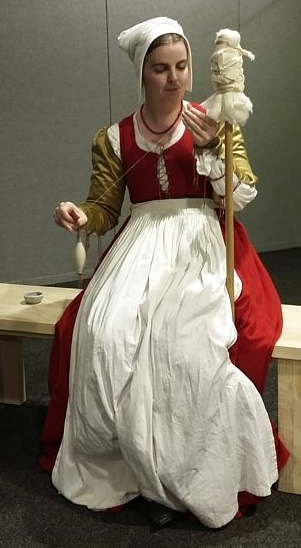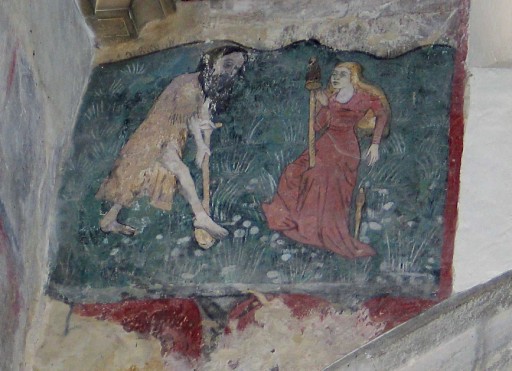So I was telling my mum about my recent spinning research and she asked me why I had been working so hard to document the style of spinning I was doing. I explained to her that a lot of people think the 15th century paintings show an artist’s depiction of spinning and it wasn’t actually how people spun. She asked me why they thought that and… I couldn’t answer her.
So I’ve been thinking.
First off, historically people did spin with the method many hobby hand spinners use today, I’m not saying it’s a modern method or was never used historically.
This is how they spun in ancient times in Greece and Egypt.

Kinda like today’s spinners and even though there’s a distaff it’s hand held so there’s still a hand taken up with holding the fibre and the other hand is used to spin the spindle and draft the fibre.
I understand that in the Americas they spun (and still do) using the drop spindle method.
I believe in many parts of Europe they moved from the ancient method to the one I’m exploring. Of course, I have to research where abouts in Europe they did that and it’s entirely possible several methods were used depending on what they were spinning.
Spinning was once a chore. It was a task that had to be done constantly. Every thread in every dress, every shirt and every bedsheet had to be spun by a person somewhere. The sails on ships? Those too. It was hard work, as many things once were. Then the industrial revolution happened and a lot of that hard work was taken out of people’s houses and given over to machines. People didn’t have to do that work any more and because it was work, why would they continue? They didn’t teach their children because why would their children want to learn how to do all that hard work their parents used to have to do?
Hand spinning now days has become a hobby in many parts of the developed world. We don’t have to do it, and see it as a craft. But by the time we started seeing it as a craft those who used to do it day in day out for producing cloth to stay warm and dressed were all dead. The knowledge hadn’t been passed on.
But the industrial revolution didn’t happen everywhere. Spinning didn’t get mechanized everywhere. Indeed, there’s places today where people still spin because they need to. For them it is still work.
I’ve read a few stories online of spinners who have relatives in these places, where spinning is till a job, and they ask their relatives to help them with their spinning and the relatives are shocked. “Why would you want to do that hard work? You can just buy what you need!” they say. A lot of the time they think it strange or silly or a waste of time to make what you can afford to buy and have access to cheaply.
But for one reason or another, we like to spin. So where do we look to learn how to spin? To the people still doing it. I know there’s lots of how to spin books and videos and websites and many of the ones I find are by Americans. Lots of them have traveled to or lived in countries where people still spin, but because these people are Americans usually they’ve been to countries in the Americas where people use the drop spindle method. So this is what they learn. Which I think is fantastic, but…
Drop spinning is often the method people learn. So when a medieval historical reenactor learns they should be spinning every chance they get and they hop online to see how to do it they are presented with two methods. Drop spinning or the supported spinning (often with tiny spindles in little bowls or big ones on the ground rolled along the thy.) The supported spinning looks nothing like what the medieval folks did so they learn drop spinning because that’s the other way.
Maybe they notice their arm positions aren’t the same as in the medieval manuscripts but then again all the pictures of spinners are painted the same anyway so it’s probably just artistic shorthand to depict a spinner. Holding your spindle out like that looks graceful. We know how to spin therefore we know how they span.







If we come at things from the angle of “we don’t know how they spun in the 15th century in Europe, lets research” then none of the evidents points towards the drop spinning style you see most modern spinners doing. At least, I haven’t seen any. They may have used the drop spinning method but I can’t find any evidence of it* therefore I won’t use it. As a living historian I recreate what I see evidence of. That’s why I took up fingerloop braiding rather than making lucet cord. I had actual manuscripts from the 15th century telling me how to braid and pictures of people fingerlooping in the 15th century and cords that had been identified as being made from fingerloop braid. At the time the only evidence for lucet braid was “some possible lucets from viking times were found and they has lucet braid in the 17th century therefore it continued in all the years between.” Considering people from all around the world invented fingerloop braiding independantly from one another, it makes sense that lucet braiding could have been used in the viking times, lost then re-invented later. Well, three times, because I once watched a child invent lucet braiding. Keep in mind, I haven researched lucett braiding for a good 7 years, more research may have come to light since then but 7 years ago there was only stacks of evidence for fingerloop in the 15th century and none for lucett.
So, that’s my theory, what do you think?




*Yes, there is evidence they suspended their spindle for a part of the spinning process. I do this also, but it is different from drop spinning as many of us know it. I’m going to write a post up about the differences soon!


































